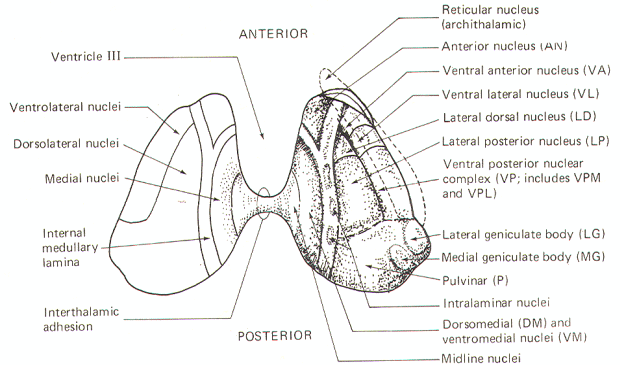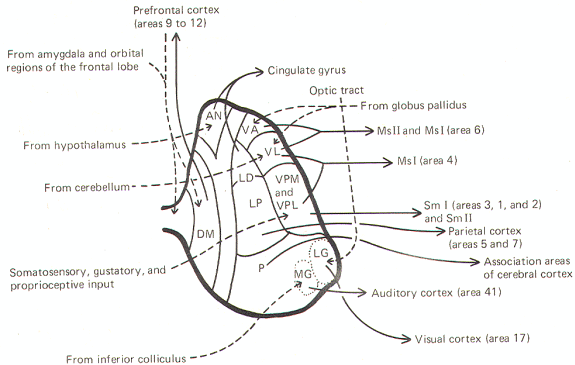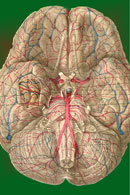|
|
|
 |
|
|
The thalamus represents the most rostral part of the diencephalon. It is composed of two large ovoid gray masses separated by the third ventricle but generally connected by a narrow commissural structure, the interthalamic adhesion (Figs-1,2 and 3). The thalamus is separated from the hypothalamus below by a narrow depression in the lateral wall of the third ventricle, the hypothalamic sulcus. It is bounded laterally by the internal capsule and anteriorly by the head of the caudate nucleus (Fig-1).
The thalamus is certainly a very important relay station in the brain and undoubtedly an important subcortical integrator as well. All of the principal sensory paths (except the olfactory system) send fibers to the thalamic nuclei. In addition, it receives input from the basal nuclei, the hypothalamus, the cerebellum, the visual and auditory systems, and most areas of the cerebral cortex. The gray matter of the thalamus is divided internally by a somewhat myelinated band, the internal medullary lamina, which opens into a Y at the anterior pole of the thalamus to effectively demarcate the anterior nucleus (AN) (Fig-3). Except for the intralaminar nuclei, the remaining nuclei of the thalamus are located in three anterior-posterior bands: the ventrolateral nuclei, the dorsolateral nuclei, and the medial nuclei. The latter two groups are separated by the internal medullary lamina. These groups, and the specific nuclei which compose them, are illustrated in Fig-3. The various afferent and efferent connections these nuclei make with the rest of the nervous system are schematically illustrated in Fig-4. A summary of the various thalamic nuclei and their connections with other components of the nervous system is presented here.
The Anterior Nuclei These are located in the most anterior and superior part of the thalamus bounded by the Y of the internal medullary lamina. While we of speak of the anterior nucleus (AN) in the singular, it is actually composed of several nuclei. They have reciprocal connections with the hypothalamus via the mammillothalamic fibers as well as with the limbic lobe of the cortex, particularly the cingulate gyrus. The Medial Nuclei The principal nuclei here are the large dorsomedial nucleus (DM) and the ventromedial nucleus (VM). The dorsomedial nucleus has reciprocal connections with the frontal lobe of the cortex, areas 9, 10, 11, and 12. It also receives input from the amygdala and orbital regions of the frontal lobe. It is reciprocally connected with most of the other thalamic nuclei as well. The Midline Nuclei The midline nuclei receive input from the brain stem reticular formation. They are also connected with the hypothalamus as well as the dorsomedial nuclei on both sides via the interthalamic adhesion. The prefrontal cortex, amygdala, and orbital region of the frontal lobe also project into these nuclei. The Dorsolateral Nuclei This group includes the lateral dorsal nucleus (LD), the lateral posterior nucleus (LP), and the pulvinar (P). The lateral dorsal nucleus is reciprocally related to the posterior cingulate gyrus, the precuneate region of the inferior parietal lobe, and the mammillary nuclei. The lateral posterior nucleus receives input from the medial and lateral geniculate bodies and the ventral posterior nucleus (VP). It also has extensive interconnections with the postcentral gyrus of the parietal lobe, specifically areas 5 and 7 and the precuneus. Likewise, the pulvinar also receives input from the medial and lateral geniculate bodies and the ventral posterior nucleus (VP). In addition, it may also receive direct input from the optic tract. It has reciprocal connections with the association areas of the parietal, occipital, and temporal cortexes. The Ventrolateral Nuclei This group includes the ventral anterior nucleus (VA), the ventral lateral nucleus (VL), and the ventral posterior nuclear complex (VP). The latter includes the ventral posteriomedial nucleus (VPM) and the ventral posteriolateral nucleus (VPL). Both the ventral anterior and ventral lateral nuclei receive input from the globus pallidus, while the ventral lateral nucleus also receives input from the cerebellum and the red nucleus. Both nuclei project to area 6 of the primary motor area (MsI) and to the secondary motor area (MsII) as well. The ventral lateral nucleus also projects to area 4 of MsI. The ventral anterior nucleus is reciprocally related to the caudate nucleus. The ventral posterior nuclear complex is the principal thalamic receiving area of the large ascending sensory systems. The VPL receives somatosensory and proprioceptive input from the medial lemniscus and the spinothalamic tracts. The VPM receives input from the trigeminal and gustatory pathways. The principal cortical projections from the VPM and VPL pass through the posterior limb of the internal capsule to the primary and secondary somatosensory areas (SmI and SmII) of the cerebral cortex. SmI and SmII also project to these nuclei. The Intralaminar Nuclei This group includes the centromedian nucleus (CM) and parafascicular nucleus (PF). Both are reciprocally related to the entire neocortex as well as other thalamic nuclei. Both also receive input from the spinothalamic tracts and the brainstem reticular formation. In addition, the globus pallidus and cortical area 4 project to the centromedian nucleus, while the parafascicular nucleus receives input from area 6.The Reticular Nucleus of the Thalamus This is a long curved nucleus which separates the lateral thalamus from the fibers of the posterior limb of the internal capsule. It receives input from the entire neocortex, the brain stem reticular formation, and the globus pallidus. Its output is primarily directed to other thalamic nuclei, and it is thought to play an important part in the reticular activating system associated with wakefulness. The Medial and Lateral Geniculate Bodies The caudal region of the ventral thalamus contains two round swellings, the medial geniculate body (MG) and the lateral geniculate body (LG). The former is an important relay center in the conscious auditory pathway. Fibers project from here to the auditory cortex of the temporal lobe. The latter is an important relay and integration center in the conscious visual pathway. It receives input from optic nerve fibers and projects output fibers to the visual cortex over the optic radiation. The pulvinar has also been shown to be neurally connected with the lateral geniculate body. In summary, it must be recognized that the list of thalamic connections is incomplete, as new studies are constantly showing additional pathways. We can also assume that the thalamic nuclei are intricately connected to each other, further clouding our understanding of any clear mechanisms which the thalamus employs in integrating the information it receives.
|
|
|
Copyright [2007] [CNS Clinic-Jordan]. All rights reserved






